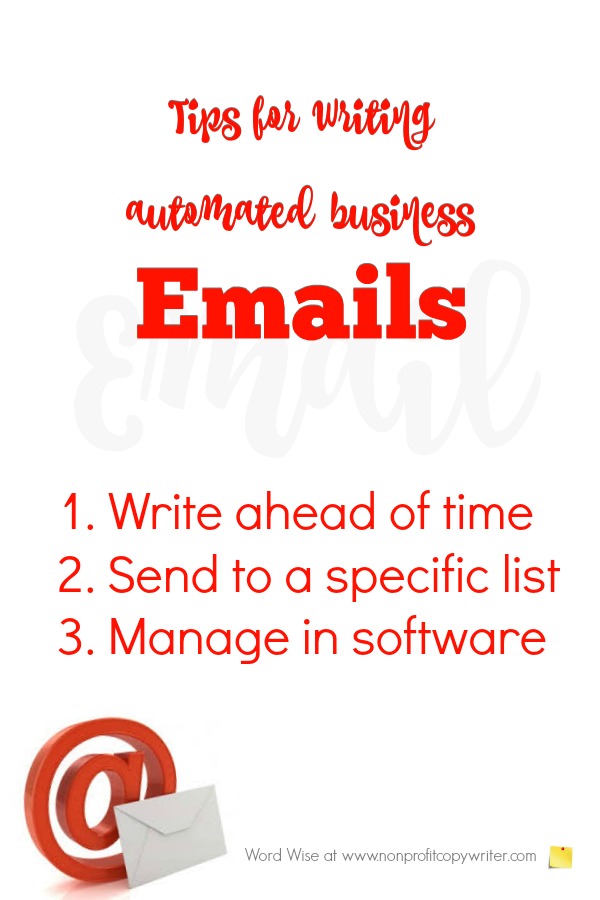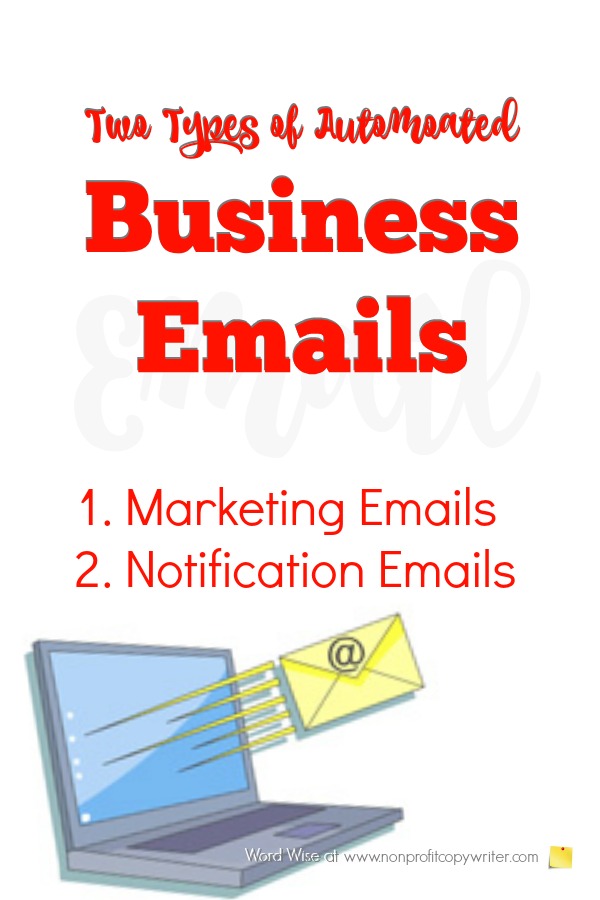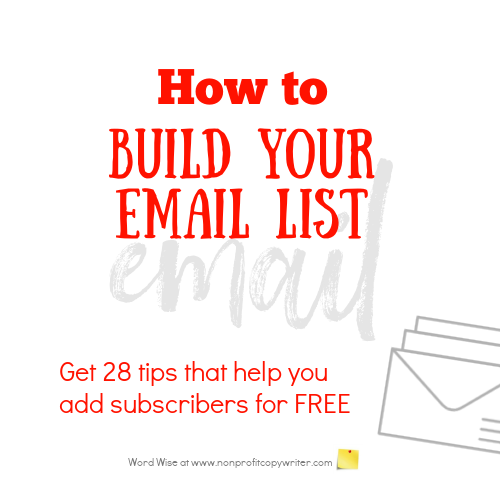Save Time: Get 5 Simple Writing Tips
you can put to use in 10 minutes
Writing Email Tips: Understand Two Types of Business Emails
Award-winning writer Kathy Widenhouse has helped hundreds of nonprofits and writers produce successful content , with 750K+ views for her writing tutorials. She is the author of 9 books. See more of Kathy’s content here.
Updated 1.19.2024
The best writing email tips – like other writing tips – zero in on practicalities. What makes a particular type of content unique? What must you remember in order to write that type of content well?
Back in 1965, email was considered to be a novelty. That’s when the first email message was posted in a file from one user to another on the Massachusetts Institute of Technology’s mainframe computer.
Decades have passed. Today, email is a widely-accepted form of communication. In fact, most of us have more than one email address. It’s not uncommon to have one email address for personal use and another for business.
Email writing is a specialty niche
Writing emails has become a content specialty. I’m not talking about the informal, one-on-one email you dash off to your cubicle partner to schedule a time to meet for lunch. Nor do I mean the emails that you send between your boss or associates to manage tasks, maintain a record of what’s done, and as reminders of what’s ahead.
Rather, there’s an entire niche of writing devoted to email marketing.
If you’re a blogger, freelance writer, ministry leader, or small business owner – well, like it not, you’re a marketer. These days, communication is conducted primarily through electronic channels – and email marketing has emerged as a powerful tool. Sixty percent of consumers say they’ve made a purchase as a result of a marketing email message they’ve received. You need to understand these kinds of emails and know the top writing email tips for producing them.
You may hear them called email blasts, bulk email, or mass email. Email marketing messages save time, reduce costs, increase productivity, and make marketing easier.
Even though email writing is a niche unto itself, you can learn the basics for writing it well and using it.
What makes email marketing messages unique
They’re automated. You format email marketing messages in an email list manager, which sends them as you direct – either when you schedule them (as for a newsletter) or in response to a trigger action (such as when a reader requests your download.)
I use and love Constant Contact. I know plenty of folks who use Mail Chimp and ConvertKit.
Writing email tips: two kinds of emails you need to know how to write
Fortunately, there’s just two main kinds of automated emails. When you understand what they’re for, you can easily grasp how to write them and how to use them to build your following.
1. Marketing emails
A marketing email is a targeted piece of content sent to a group of readers with a specific purpose: to promote a product, service, or brand.
It is a form of direct communication that allows you to reach your readers in a personalized manner with relevant information. When you send a marketing email, you have a greater chance to engage them – much more so than with a random ad or social media post. According to the Direct Marketing Association (DMA), email marketing has consistently demonstrated a high return on investment, making it an integral component of a solopreneur’s or small biz owner’s marketing strategy.
You send marketing emails in bulk – rather than a single reader at a time.
These readers have given you permission to communicate with them as a customer or in an opt-in. You may also send marketing emails to a purchased list of qualified readers.
A marketing email contains content that valuable to this group of qualified readers, such as special deals, information, and incentives. You use the marketing email content to cultivate prospects, build loyalty, trust, and brand awareness, obtain sales or donations – or any combination of these.
Examples of Marketing Emails
- Ezines
- Online appeals
- Campaign series
- Special sales or promotions
- Industry news
- Product announcements
- Invitations
- Event registrations
2 top writing email tips for a marketing email
- Write a subject line that offers a benefit. A marketing email’s purpose is promotion. You can’t promote unless your reader opens the thing. “XYZ Newsletter” is not a subject line that inspires a click or demonstrates an advantage. How about “Save 20% this week only”? Yes, please.
- Give a clear Call to Action (CTA). Spell out what you want your reader to do. Use a command. If your marketing email is a newsletter, then tell your reader to “Click here to read more.” If you’re announcing a webinar, tell her to “Grab your seat here.”
2. Transactional emails
A transactional email is written, loaded, and preprogrammed to be sent automatically after a reader takes an action, like a purchase. They’re called an autoresponder or trigger email or notification email.
In other words, your email confirms the transaction you’ve just had with your reader. Your email list manager allows you to create a transactional email and schedule it to be sent as soon as a subscriber triggers it.
You send a transactional email to a single reader at a time – rather than in bulk to a group.
Plus, you can use a transactional email to grow your online relationships with customers and users beyond a simple confirmation or follow up. Data and credit specialist Experian reports that transactional emails that include personalized product recommendations can increase revenue by 20%. They reinforce brand identity.
Examples of transactional emails
- New account confirmation
- Registration confirmation
- Order confirmation
- Welcome message
- Lead magnet delivery
- Payment confirmation
- Subscription confirmation
- Account termination
- Shipment tracking and order status
- Invoice
- Birthday Greetings
- Holiday Greetings
- Greetings after a purchase
- Shopping Cart update
- Stock availability notification
- Discounts on additional products
- Purchase follow up and upsell
- Feedback request
3 top writing email tips for transactional emails
- Rewrite what’s already there. Email marketing managers, like Constant Contact, offer templates for automated transactional emails – typically with a subject line that reads, “Confirmation” and body content like this: “Thank you for your purchase.”
Snore. Yes, you’ve got a starting point. But you need to overhaul the subject line and content so that you don’t sound like AI. Rewrite your subject line like this:
Here’s the State Fair Blue Ribbon Apple Muffin recipe that will earn you a standing ovation - Ditto for the body content. You’ll need to overhaul the prepackaged email content that says, “Thanks for subscribing.” Get right to the point – with some pizzazz. As you rewrite the preset auto responses, don’t waste time or words. Tell the reader what to do. And add some personality.
Click here to get your copy and pull out the cinnamon. You’re on your way to baking bliss. - Upsell. Your reader has made one transaction, whether it’s making a purchase or signing up to volunteer. Use your transactional email to get her to interact with you once more. You can offer her a discount on another product … promise to notify her when your next product is released … ask for feedback.
Since you like to bake, you may want to join our Monthly Muffin Club for just 99 cents a month. Click here to learn more.
Top writing email tips for these 2 kinds of emails
It’s easy to go with your email marketing manager default settings. Don’t be that kind of slacker.
Email is a valuable tool. If you personalize your marketing emails and transactional emails – and give relevant information with a clear call to action, your readers will notice.
Because most small biz owners and solopreneurs don’t.
More Email Writing Tips
Avoid These 6 Throwaway Opening Lines ...
Should You Build an Email List? Advantages and Disadvantages ...
How to Build an Email List for No (or Very Little) Cost ...
What’s the Ideal Email Length?
How NOT to Be a Pest When You Write Email Reminders ...
Start and Grow Your Email List: A Simple Tutorial ...
Free downloadable checklist for writing better email subject lines ...
Email copywriting: the anatomy of a strong email campaign ...
How to write an email step-by-step ...
Email Campaign vs. Ezine: What's the Difference?
Business Email Writing Tips to Help You Save Time and Save Face ...
How to Write More Powerful Lead Magnets: 5 Easy Steps ...
Three tips to increase your email open rate ...
Email Writing Tips: a tip for savvy subject lines ...
Email Writing Tip: how to write links to get more clicks ...
Why nonprofit emails are a powerful promotional tool ...
Do's and don'ts for email subject lines ...
Netiquette: email etiquette for copywriters and leaders ...
More email writing tips on our Pinterest board ...
Return from Writing Email Tips: 2 Types of Business Emails to
Nonprofit Copywriter home
As an Amazon Associate I earn from qualifying purchases.
Share This Page

Named to 2022 Writer's Digest list
BEST GENRE/NICHE WRITING WEBSITE


Stop Wasting Time!

Grab your exclusive FREE guide, "5 Simple Writing Tips You Can Put to Use in 10 Minutes or Less"














